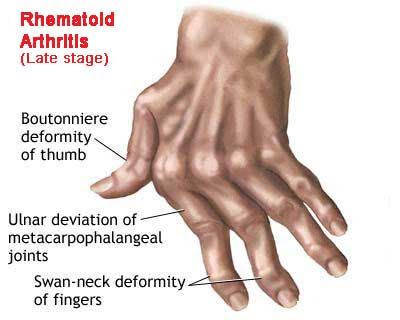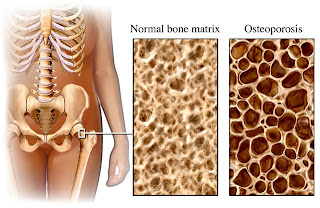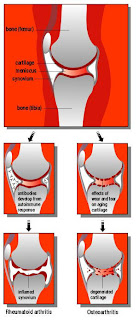>
People with rheumatoid arthritis have to be thoroughly sick of hearing doctors let know them they have an autoimmune disease, the body is fighting and destroying their own together with an inflammatory condition. They often fail to tell them they have to do your body strong, to give some parts of the chance to fight back, to slow or even stop the deterioration. After the fight back really begins.
Imagine your body trying to fight inflammation. What does he need? To start it would take blood from your liver healthy, containing healthy, oxygen from the lungs. Would have to eliminate the toxic inflammation around the joints so it would be necessary for healthy kidneys turgid clear fluids and a healthy gut for elimination of toxic waste.
One of the most important things to help arthritis is a good elimination. The body is so choked with toxic inflammatory that needs to clean itself. Many of the toxic joints remain there because the body can not transfer them.
You must find the right diet before you can do anything with the joints.
And with all this toxic inflammation and heat that you need to cool the joints and lubricate the system with water. Clear, fresh clean water - not treated with additives or flavorings. Drinks five liters a day - eight glasses. Keep a glass or bottle of water with you at all times and keep drinking. Drink to good health! You can count on fresh fruit juice and vegetable consumption among the eight glasses.
These drinks will help make healthy kidneys. Then, they can purify the blood and this will help the heart, which in turn will help your joints.
The kidneys are one of the most important organs of the body to clear the inflammation of the joints. However, the poor old things are starved of fluid and fight to clean the blood. If the kidney energy is low, get constipation, low energy, headaches, swollen ankles and joints, excessive period pains, ear problems, fatigue and difficulty in the chest.
At the same time help the joints and inflammation with natural products and then have a new look for your problem when you have done yourself healthy. There is much that can be done with a healthy body, including massage of muscles and joints, mobilization, acupuncture and breathing exercises.
Read more on natural arthritis treatment and arthritis pain relief products.
Wednesday, November 2, 2011
Rheumatoid Arthritis
Posted by Tyo at 1:10 AM 0 comments
Labels: arthritis, constipation, immune system, joints and inflammation, rheumatoid arthritis
Saturday, October 15, 2011
Arthritis difficulty performing activities
> It is a disease characterized by inflammation of one or several joints, pain, feeling of stiffness in wrists, knuckles, fingers, elbows, shoulders, hips, knees and ankles, and difficulty performing daily activities. When you make a move, the body smooths friction between the bones supported by cartilage, which in turn are protected and covered by a membrane, called synovium. When the latter was invaded by damaging cells or excessively secretes fluid, there is the condition, which occurs most often between 45 and 55, and can also affect children.
It is a disease characterized by inflammation of one or several joints, pain, feeling of stiffness in wrists, knuckles, fingers, elbows, shoulders, hips, knees and ankles, and difficulty performing daily activities. When you make a move, the body smooths friction between the bones supported by cartilage, which in turn are protected and covered by a membrane, called synovium. When the latter was invaded by damaging cells or excessively secretes fluid, there is the condition, which occurs most often between 45 and 55, and can also affect children.
* It is characterized by inflammation of tissue covering the cartilage and joints (synovium). In this category there are two types of arthritis, polyarthritis (which hurts more than five joints) and rheumatic fever.
* The former is more common, usually appears after age 50, affects joints of the hands, wrists and forefoot, and causes pain, swelling, stiffness and deformation. It is favored by the depletion or infection.
* The second appears 2 to 3 weeks after suffering tonsillitis (inflammation of the throat caused by a virus) treated badly, that for unknown reasons leading to the production of antibodies directed against itself. Affect knees, ankles and elbows, causing painful inflammation of short duration.
Causes
* Genetic predisposition.
* Sudden temperature changes in the joints, for example, be continuously in contact with hot and cold water.
* Invasion of infectious agents.
* Accumulation of uric acid crystals and calcium salts in the joints.
Symptoms
* Inflammation of joints.
* Severe pain during the night may wake the patient.
* Difficulty moving.
* The skin of the damaged area becomes pink color, red or purple.
* Fever.
* Fatigue.
* Tingling in hands or feet.
* In some cases, deformed hands and feet, mainly.
Prevention
* When you have a genetic predisposition is more difficult to prevent, however to avoid temperature changes in the joints.
* We recommend taking a daily bath with hot water as this helps to reduce stiffness and morning joint stiffness.
* Avoid activities requiring great physical effort, standing compel or require repetitive movements, especially with the hands.
* To perform household chores should not force their hands, for example, it is advisable to twist the clothes to squeeze, open screw caps and press hard cutlery handles, among others.
* It is very important to follow a complete treatment of tonsillitis, to avoid resulting in arthritis.
Consult your doctor.
Read more on remedies for gout and natural treatment of joint pain. For more info about remedies for arthritis Visit: http://www.swamiramdevmedicines.com/packages-for-diseases/arthritis-joint-knee-pain.htm
Posted by Tyo at 1:43 AM 0 comments
Labels: arthritis, arthritis treatment, feeling of stiffness in wrists, Infectious arthritis, joints, pain, pain and stiffness in joint
Saturday, October 8, 2011
Osteoporosis a Silent Disease, Know its Causes and Treatment
> Osteoporosis is known as a silent disease because many people only discover they have it when they suffer a broken hip or a small accident, how to close a stuck window or open a bottle, and this results in a broken wrist.
Osteoporosis is known as a silent disease because many people only discover they have it when they suffer a broken hip or a small accident, how to close a stuck window or open a bottle, and this results in a broken wrist.
The factors leading to osteoporosis and measures that can be taken to minimize the effects of the disease make proper diet and choose certain lifestyles.
Osteoporosis Causes:
The causes of osteoporosis are unknown. However, the chances of acquiring it increase dramatically with aging, especially in women. A prevailing theory is that osteoporosis results from the loss of estrogen, a female hormone that affects the calcium content of bones. Menopause can lead to osteoporosis, as estrogen production decreases considerably at that time.
For unknown reasons, osteoporosis occurs more in white and Asian women than black women. Furthermore, the thin, especially those of very light skin, are at greater risk than fat women with dark skin.
The disease can also be caused by other factors: the surgical removal of both ovaries and the onset of chronic arthritis or inflammation of the joints can lead to osteoporosis, sedentary people, whether by choice or because of disease, are more susceptible to disturbance.
A diet low in nutrients, especially calcium promotes the development of bones, may also contribute to osteoporosis. People who use drugs with steroids for a prolonged period to treat other diseases are in an area of significantly greater risk. Other risk factors include smoking, early menopause and osteoporosis cases in the family.
Osteoporosis Symptoms:
Depending on the strength of bones, osteoporosis can have no symptoms and no pains in its early stages. If there is pain, is more common to occur in the lower spine. The disease poses no threat to life, but it causes fractures, which, in the elderly, can result in serious complications. In principle, the shooting pains in the spine can be caused by fractures in the bones of the spine (vertebra).
Prevention and Osteoporosis Treatment:
The doctors encourage patients with osteoporosis to follow an exercise program that will assist in strengthening the muscles that support the bones weak. However, to protect the bones of the spine, you should avoid carrying heavy objects. In advanced cases, it may be necessary to use a vest to help support the body weight while sitting and rising.
People prone to fractures must exercise and follow a balanced diet to prevent and control disease. Foods rich in vitamins and minerals, especially calcium and vitamin D stimulate bone formation. When the diet does not rely on these nutrients, your doctor may prescribe supplements of vitamins and minerals.
Osteoporosis has no cure, so the best line of defense is prevention. If you wait too long to worry about the disease, may be too late to reverse the damage. There are some steps that can be followed to prevent future bone loss.
* Follow a diet rich in calcium and vitamin D;
* Getting regular exercise;
* Have a healthy lifestyle, avoiding smoking or abusing alcohol;
* Perform a bone densitometry and take appropriate medications as needed.
* Milk is good for health, especially in the fight against osteoporosis
Of course the best way to prevent bone loss is to know what causes it exactly.
Read more on osteoarthritis of hip and Joint Pains Relief remedies.
Tuesday, October 4, 2011
Osteoarthritis Feeling Pain and Morning Stiffness in Joint
> Osteoarthritis What Is It?
Osteoarthritis What Is It?
It is a chronic disease of the joints characterized by degeneration of cartilage and adjacent bone may cause joint pain and morning stiffness, less than 10 minutes. . Speaking of statistics we can say that affects 50% of people over 65 years. And after 70 years, 90% suffer from osteoarthritis.
Osteoarthritis is more common in older people but young people are not free of suffering, showing few or no symptoms, for the simple act of walking or performing activities such as opening or closing a hand, writing, opening a door there are bumps or trauma, which over time begin to generate changes in cartilage.
Osteoarthritis Causes:
Aging
Misuse of joints
Obesity
Local lesions
Is an inherited disease
Sedentary
Lack of exercise
Osteoarthritis Symptoms:
Pain in ankles, hands, knees, hips, spine and joints (depending on where you are affected by osteoarthritis)
Bone deformities
Morning stiffness or rigidity of rest
Swollen joints
The rough cartilage causes joints squeak or creak when you move
Bone growth also compresses the nerves, arthritis in the neck or lower back can cause hardening, strange sensations of pain and weakness in an arm or leg. Osteoarthritis is a chronic process, which is part of the aging person. Just as hair turns white and remains hair, the skin loses its morphology and wrinkled. Which does not mean that it no longer functions but has changed some features? Just change the cartilage, so that osteoarthritis is a chronic change of aging, but aggravated by the factors mentioned above.
Osteoarthritis is a slow development in most cases after onset of symptoms, so the first sign please go to the doctor.
Diagnosis
Can be detected clinically by the type of pain, conditions that improve or worsen with a simple exploration of the affected joints.
Osteoarthritis of the joints of the hands show the typical deformation of the fingers, while the knee begins to swell the bone by the spill of liquid, which is usually not bothersome.
Osteoarthritis may be confused with arthritis, present almost the same symptoms, so it is important to consult with your doctor to establish the diagnosis.
The rheumatologist performed a series of tests including:
X-ray
Blood test
Types of Arthritis
Osteoarthritis is classified into two types:
Primary osteoarthritis - That is when the cause is unknown.
Secondary osteoarthritis - is when the cause is another disease associated with metabolic diseases like diabetes mellitus, hyperthyroidism, and so on.
Treatment
There is currently no treatment that can cure osteoarthritis, but can be controlled, slowing its progress to improve the quality of life of patients. The first anti-inflammatory treatments as you are.
The treatment is a combination of factors including:
Medications
Maintain a healthy weight
Eating a balanced diet recommended by your doctor
Perform strengthening exercises and postural
Eat fish 2 times a week helps reduce inflammation
Posture changes in sleep habits
Heat and cold treatments it may relieve the feeling of stiffness temporarily. The cold can relieve pain for some people while the heat is very effective in relieving stiffness.
Read more on remedies for osteoarthritis disease and natural treatment of joint pain. For more info about remedies for arthritis
Sunday, October 2, 2011
Common Knee Problems
> The knee is a vulnerable joint that bears a great deal of stress from everyday activities such as lifting and kneeling, and other high impact activities such as jogging and aerobics.
The knee is a vulnerable joint that bears a great deal of stress from everyday activities such as lifting and kneeling, and other high impact activities such as jogging and aerobics.
The following parts form the knee:
* Tibia - shin bone or larger bone of the lower leg.
* Femur - thigh bone or bone of the upper leg.
* Patella - flat bone located in front of the knee joint.
The ends of bones are covered by a layer of cartilage that absorbs shock and protects the knee. Basically, the knee is the confluence of two long leg bones connected by muscles, ligaments and tendons.
There are two groups of muscles in the knee: the quadriceps muscles (located on the front of the thigh), which straighten the leg and back muscle of the thigh, which bend the leg at the knee.
Tendons are tough cords of tissue that connect muscles to bones. Ligaments are elastic bands of tissue that connect bones to each other. Some ligaments of the knee provide stability and protect joints, while others limit the movement of the tibia (shin bone) forwards and backwards.
What are common knee problems?
Many knee problems are the result of the aging process and continual wear and tear of the knee joint (i.e. arthritis). Others are the result of an injury or a sudden movement that strains the knee. Among the most common problems of the knee include:
* Sprain or strain of the ligaments and muscles of the knee or usually, this occurs when the knee suffers a blow or a sudden twist. Often, the symptoms include pain, swelling and difficulty walking.
* Torn cartilage- A knee injury can tear the menisci (pads of connective tissue that act as shock absorbers and also enhance stability). Cartilage tears can often occur with sprains. Treatment may involve wearing a brace during an activity to prevent further damage to the knee. May be called for surgery to repair the tear.
* Tendinitis- Inflammation of the tendons may occur as a result of overuse of a tendon during certain activities like running, jumping, or bicycling. Tendinitis of the patellar tendon is called jumper's knee. This condition is frequently seen in sports such as basketball, in which the force with which it hits the ground after a jump strains the tendon.
* Arthritis
- Osteoarthritis is the most common type of arthritis affecting the knee. Osteoarthritis is a degenerative process in which the joint cartilage gradually wears away, and usually affects middle-aged or older. You can be the result of excessive force on the joint such as repeated injury or being overweight.
- Rheumatoid arthritis can also affect the knees by causing the joint to become inflamed and destroying the knee cartilage. Compared with osteoarthritis, rheumatoid arthritis tends to affect younger people.
Read more on Arthritis Remedies and Joint Pains Relief and Rheumatoid Arthritis Treatments.